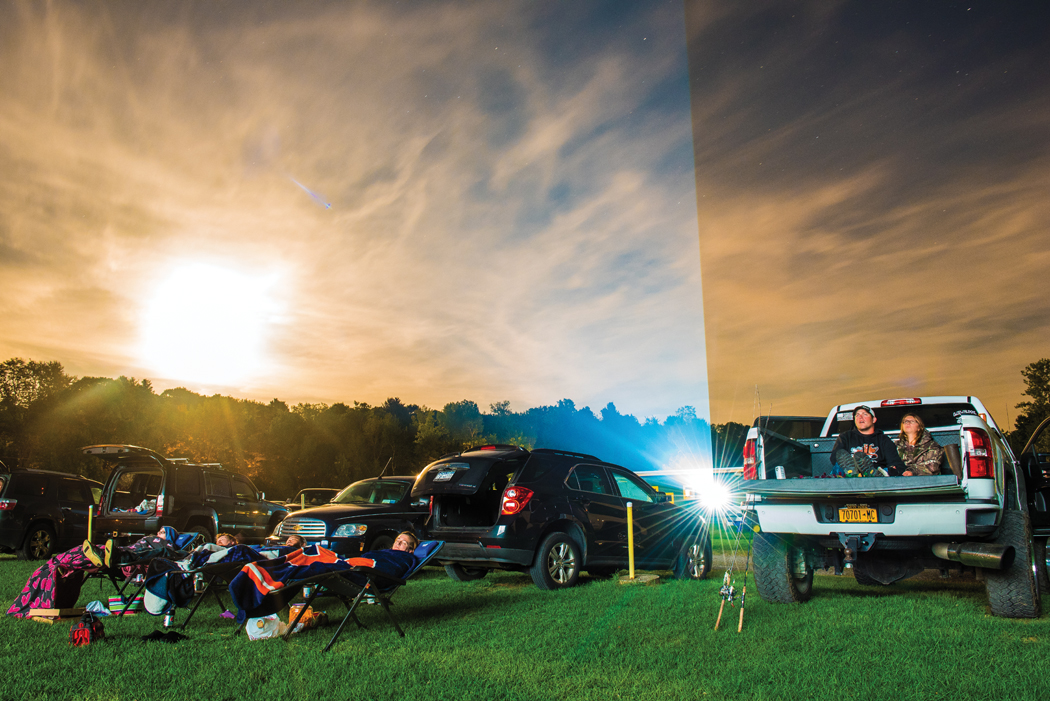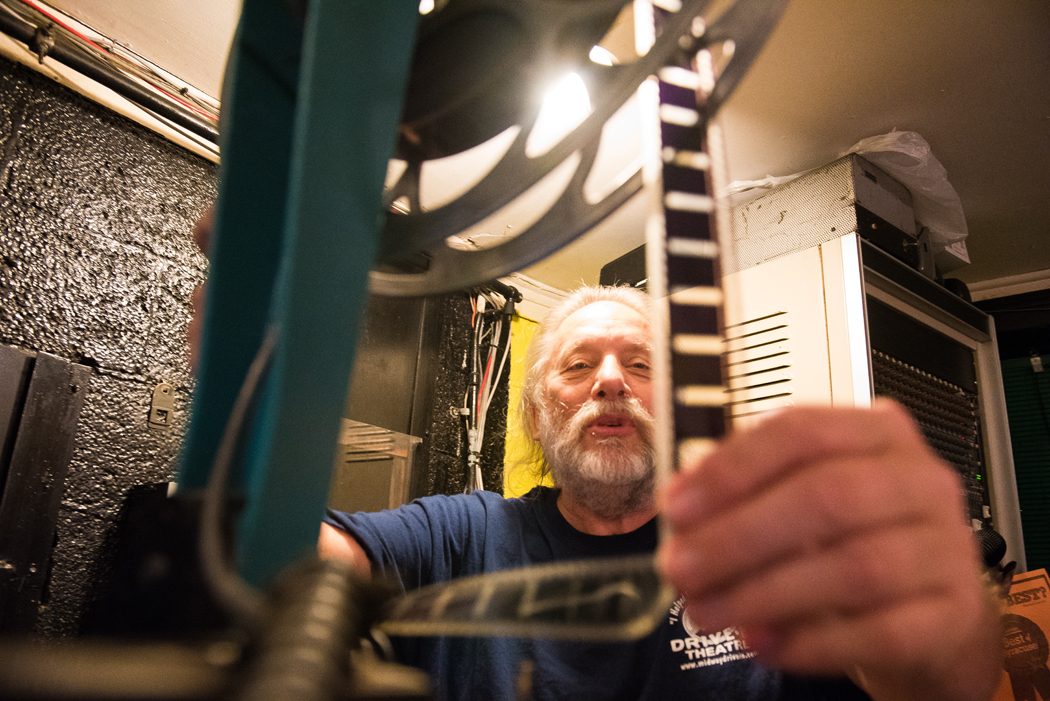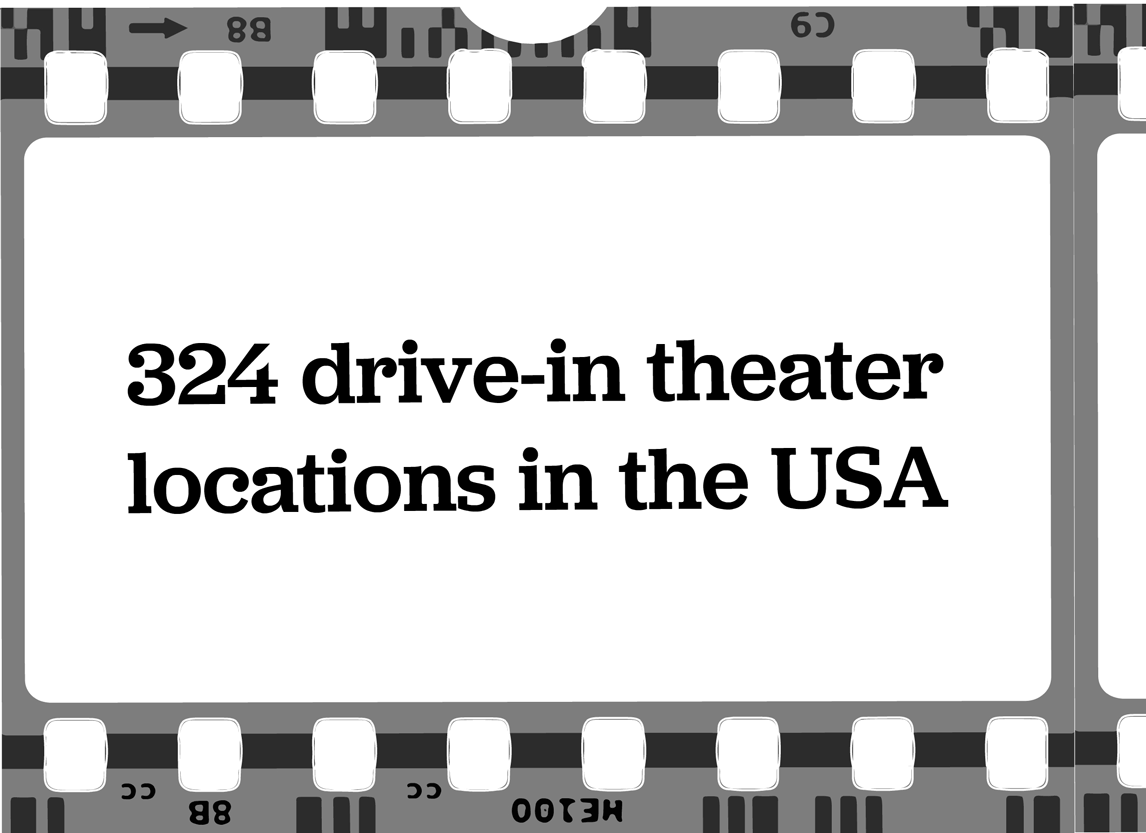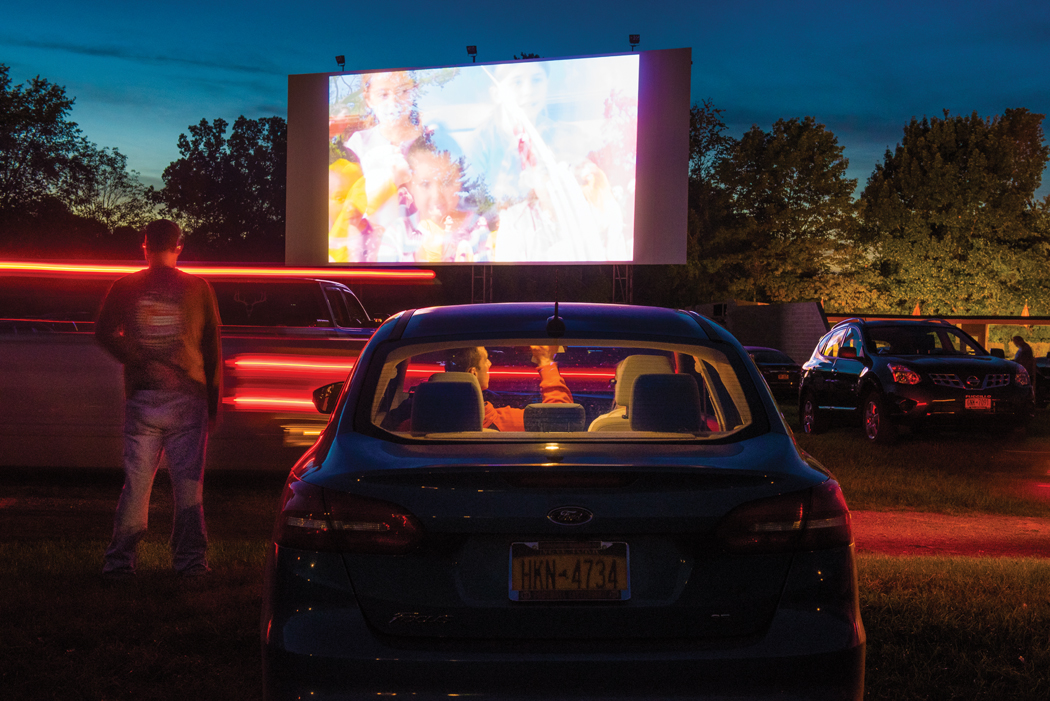UPDATED: Sept. 21 at 5:50 p.m.
MINETTO, NY — It felt like a wake.
Hundreds of cars pulled into the normally joyous lot, as people flocked to see, and to cry, as Minetto, New York’s most iconic landmark had been torn to pieces by a microburst storm.
Pieces of the Midway Drive-in’s 1968 wooden screen were lodged more than a foot into the ground, and a brick retaining wall near the ticket booth had fallen. The 600-car lot looked like a debris field. The summer of 2014 would live on in the nightmares of the owners, staff and community.
“If the storm had hit 30 minutes later, people would have been here,” said John Nagelschmidt Sr., the Midway’s owner. “They could have died.”
The previous summer, the theater, which is a 45-minute drive from Syracuse University, made the jump from film projection to digital, which cost more than $100,000. The wooden screen was underinsured, and the reserves were drained.

Chase Guttman | Staff Photographer
The future of the Midway looked bleak.
Over five decades, the one-screen theater outlasted VCRs and Blockbuster and had hung on in the face of luxury theaters and online streaming — but this seemed to be the breaking point.
The theater’s wake turned into a community effort to “rebuild the Midway.” A massive fundraising campaign and local support kept the landmark alive.
But across the country, drive-in theaters’ wakes turned into funerals.
Midway is one of 324 drive-ins still operating in the U.S., a number that in its peak reached 4,063, according to the United Drive-in Theater Owners Association.
In conversations with New York State drive-in owners, they said staying open isn’t a secret recipe of nostalgia, snack bar food and selecting the right movies; it lies somewhere in the randomness of chance. They’re a physical link to the past, a link that weakens every year as drive-ins continue to close.
One of the biggest factors is the physical location of the drive-in, said Rick Cohen, owner of the Transit Drive-in Theatre near Buffalo.

Kiran Ramsey | Digital Design Editor
When drive-ins were built, they were mainly placed on cheap farmland. But as communities grew, the need for land increased and property value went up. Drive-ins weren’t practical.
“We are only open in the evenings, pretty much have two shows a night between 8 p.m. and midnight, and the majority of our business is only happening on the weekend, and on top of that in the northeast it’s seasonal,” Cohen said. “Six months out of the year you aren’t even open for business, so how can you justify it being open?”
There used to be five drive-ins in Onondaga County, some just a short drive from the Syracuse University campus, but their imprints have long since faded.
But even a perfect location doesn’t guarantee success; the switch from film to digital was too big of a leap for some owners, while others didn’t have family or staff willing to continue the demanding seasonal job.
Cohen, 48, still has a long time before he retires, but doesn’t have an heir to the largest drive-in theater in the northeast. Transit boasts five screens and a sprawling, rocky parking lot in a prime location between Buffalo and Niagara Falls.
“My family doesn’t want anything to do with it,” Cohen said. “Maybe I will send out some golden tickets, and be like Willy Wonka, when that time comes, and find somebody with a good heart that wants to keep it open.”
This interactive map highlights the current drive-ins open in New York state and the ones that have closed in Onondaga County.
On a cool September night at the end of drive-in season, John Nagelschmidt Jr., the Midway’s co-heir, is leaning against the far wall of the projection booth.
“What year were you born?” he asks.
“1996.”
“Was it in the summer time?”
“Yeah, actually, Aug. 9.”
Turning to a small desk in the corner, he rifles through piles of miscellaneous junk, before pulling out a tattered notebook.
Quickly, turning the stained and faded pages, he points with a yellowed smoker’s fingertip toward the bottom of the page.
Aug. 9-15 Harriet The Spy
Twister
The Arrival
The small book, which begins in the ‘70s, acts as a chronicle of both movies that define popular culture and the drive-in customers’ most intimate moments.
A small child seeing an unimaginable world during “Star Wars IV: Empire Strikes Back.”
A tentative first kiss that years later ends at the altar.
A widow sprinkling the ashes of her husband at the spot they had their first date.
“It just seems to be a neat little escape for people,” Nagelschmidt Jr. said. “It’s sort of frozen in time.”
At a quick glance, it’s easy to see what he means. The original 35mm film cartoons and graphics still crackle on the screen before the movie and during intermission.
Cartoon snack bar foods dance across the screen singing, “Let’s all go to the Lobby,” shortly after a psychedelic 1960s Pepsi commercial flashed madly proclaiming, “Son of a gun, it’s refreshment time!”
The snack bar’s early-1900s-style art deco curves gently glow with teal and white carnival lights, beckoning customers into the theater’s main source of revenue.
The theater is nestled against a wooded backdrop that gives no hints of the current year.
But a closer look muddles that nostalgic vision. 2000s-era automobiles sit in the audience pointed at jagged angles toward the recently-installed 80×40 steel screen.
Movies are shipped to the theater as hard drives that look more like GameCube cartridges than film reels.
Nagelschmidt Sr., 73, notices every difference, and oftentimes misses the way things used to be.

Chase Guttman | Staff Photographer
He started working at the drive-in when he was 17, as a part-time projectionist. He managed the place into the ’80s, when the owners asked if he wanted to buy it. He couldn’t refuse.
His normally tepid and thoughtful voice picks up momentum whenever he talks about the past.
“This machine still works,” he said, tapping the 35mm film projector.
Pulling a side panel, he talks through the old film projection system. His son stands close to his side, taking careful mental notes.
“The film has marks on it — little dots, and you would watch the screen. There would be a little bell here at the top, and when it rang you had 30 seconds to switch projectors,” said Nagelschmidt, wearing a black shirt, with the words “I helped rebuild the Midway” on his chest.
If you timed it right, it would happen between frames, and no one would notice the change.
The drive-in is changing light sources; the family hopes no one notices. It’s the mandatory switch from old to new while trying to hold onto the magic of yesterday.
Nagelschmidt Jr., 45, walks to a small microphone hanging from a large computer. He makes the preview and intermission announcements, a role his father held for decades.
“You said one too many triple features,” Nagelschmidt Sr. said.
“I think I said quadruple.”
“You did all right with all the attention.”

Kiran Ramsey | Digital Design Editor
The duo works in quiet tandem throughout the night, ensuring that guests have their own individual experience that doesn’t encroach on the whole.
Nagelschmidt Jr. does the heavy lifting. His eyes constantly shift to the lot, in search of accidentally-turned-on headlights, teenagers trying to sneak in from the road and the occasional dead car battery.
His father looks on, chats with regulars and ensures the night goes smoothly. His long white hair and matching white beard are instantly recognizable.
Even if you didn’t know he was the owner, you could tell, as every footstep is planted confidently in his domain.
During a free moment toward the end of the second movie, Nagelschmidt Jr. lights a cigarette outside the projection booth.
“I’m glad you’re here. He doesn’t talk about a lot of this older stuff,” he says, then pauses and looks toward a minivan whose headlights turn on, but just as quickly turn off. “Until recently, I didn’t even know he wanted me to take over.”
He leans tiredly against the projection booth door, and looks at the place he grew up — his second home.
He takes a long drag and nods his head.
“This place is magical…” but before he could finish his thought, the minivan’s lights flick on and he disappears into the night.
CORRECTION: In a previous version of this article, one of the titles in the small book handled by Rick Cohen was misidentified. The correct title is “Harriet The Spy.”

Chase Guttman | Staff Photographer
Banner photo by Chase Guttman | Staff Photographer
Published on September 20, 2016 at 10:01 pm
Contact Jacob: jagedets@syr.edu

